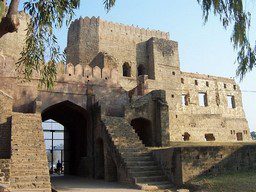Title: Remembering Freedom fighter Wazir Ram Singh Pathania
Ram Singh Pathania (1824-1849):
Before the mutiny or the first war of Independence of 1857, the Indians fought several large and small-scale battles to free their territories.
Here we will cover the story of a brave Rajput of Kangra valley (Himanchal) who declares war against the East Indian Company and even killed and defeated them in several pitch battles.
This is the forgotten story of Veer Ram Singh Pathania and his forgotten army who initiated an armed insurrection against the Raj and shook them to its core.
This astute Rajput military leader was born on 10 April 1824 at Shyam Singh Pathania’s house, the wazir of king Veer Singh.
However not much is known about the early history of Ram Singh Pathania. His real history starts with the end of the first Anglo-Sikh war (1845-1846). It is believed that after this war there was a treaty between the British and the Sikhs due to which most of the territories of Himanchal Pradesh were absorbed by the British Raj. The treaty is believed to be signed on 9th March 1846 at Lahore. By this treaty, the region between Beas and Sutlej fell into the British dominion.
At this time Veer Singh, the king of Nurpur died and the cunning British decided to annex the Nurpur princely state through their decoying policies.
The British officials took all the rights of the minor king i.e. Jaswant Singh in 5,000 rupees and declared Nurpur as their territory.
But the brave Rajput had other plans. He allied with the fellow Rajput brothers which belonged to the Katoch branch. However, this handful army of Rajput’s couldn’t stand a chance against the enemy who had conquered the whole of India but the never say die attitude of the Kshatriya did whatever they can to protect their land.
The British also promised to give some manor and a huge amount of money but proud Ram Singh Pathania refused to agree on this. At the same time, the British played their divide and rule politics.
They wanted to spark the bitterness between the relation of the Sikhs and the Hill people of Himanchal. Initially, they were successful but with the rise of Ram Singh, these tactics failed.
It is believed that neighboring kings warned Ram Singh Pathania about his ambitions but the latter didn’t pay any attention to it.
Rajputs Against the Expansionist British
On the night of 14 August 1848, Ram Singh Pathania with his small Rajput army attacked the fort of Shahpur Kandi which was situated on the bank of river Ravi. The British army inside the fortress was completely shocked by this attack.

Initially, they decided to give a fight but the charge of the Rajputs was so fierce. Many of the British troops died in this battle and when casualties reached their zenith the British forces decided to retreat from the fort to save themselves from being slaughtered.
This was perhaps the first time when the Indians armed with only traditional weapons defeated the British so badly that the latter decided to flee from the battlefield.
The next day Ram Singh Pathania hoisted the flag of Nurpur Princely state on the top of the fort. A sense of freedom was spread among the locals and it generated a feeling of Nationalism among the people.
Ten-year-old minor Jaswant Singh was proclaimed as the king and Ram Singh Pathania will be his wazir. Both of them decided to free the rest of the territories from the clutches of the Raj.
Note: The struggle against the British Raj was continued from 1846- 1849 in which Ram Singh Pathania harassed the colonial regime.
When news of this defeat reached Hoshiarpur the British immediately decided to finish this rebellion. They sent a strong force towards the fort of Shahpur. The handful of Rajputs couldn’t able to match the firepower of the advanced weapons of the British and decided to retreat from the fort.
With this achievement, fresh troops were again sent to capture Ram Singh Pathania and due to this, the latter took shelter in Gujarat where around 400 men from local villages joined his army.
War Goes On: Help From Sikhs
After some time in the year 1849 CE Ram Singh Pathania re-launched his struggle and this time King Sher Singh of Punjab also helped in his struggle. Sher Singh sent a force of 100 cavalries along with 500 infantry of the Sikh Regiment to help Ram Singh and his Rajput men.
In return, the British sent a huge force under the command of Brigadier Wheeler. The war was a total carnage and in this encounter, both sides suffered heavy losses. The battle lasted for several days.
In this vehement war, an officer John Peel was killed by the sword of Ram Singh Pathania. The former was the nephew of the then British Prime Minister Sir Robert Peel.
However, there are no shortages of traitors in our country. Due to these traitors, our country had suffered a lot. Ram Singh Pathania was also betrayed by one of his men who gave them the formers’ information.
The British arrested Ram Singh Pathania (in the year 1849) when the latter was conducting his morning rituals (Pooja) on the banks of river Ravi. Even at this time when Ram Singh was unarmed, he was able to kill two British soldiers.
The British imprisoned him for the rest of his life. Initially, they sent him to the fort of Kangra but later they sent him to Rangoon and continuously tortured him.
But the brave Rajput didn’t compromise with the British and followed the centuries-old tradition of Rajput loyalty towards its motherland. It is said that from the achievements of this young Rajput of Kangra the British didn’t able to sleep for months.

No comments:
Post a Comment